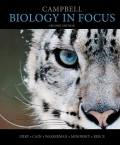
The reactivity of an atom arises from
- A. the average distance of the outermost electron shell from the nucleus.
- B. the existence of unpaired electrons in the valence shell.
- C. the sum of the potential energies of all the electron shells.
- D. the potential energy of the valence shall.
Introduction:
An atom is the smallest possible particle of an element. It is the basic unit of any structure found in the universe. Two or more atoms together make a molecule.
Answer to Problem 1TYU
Correct answer:
The reactivity of an atom arises from the existence of unpaired electrons in the valence shell.
Therefore, option (B) is correct.
Explanation of Solution
Reason for the correct statement:
Unpaired electrons in a valence shell are unstable in nature and in order to become stable, an atom can lose or gain electrons and becomes reactive.
Option (B) is given as “the existence of unpaired electrons in the valence shell”.
As “the reactivity of an atom arises from the existence of unpaired electrons in the valence shell”, it is the right answer.
Hence, option (B) is correct.
Reasons for the incorrect statements:
Option (A) is given as “the average distance of the outermost electron shell from the nucleus”.
If the distance of the outermost electron shell is large, then there would be a lesser nuclear effective charge. Thus, an electron can easily be expelled out of its shell. Thus, it does not cause an atomic reactivity. Hence, it is the wrong answer.
Option (C) is given as “the sum of the potential energies of all the electron shells”.
The sum of the potential energies of all the electron shells affects only the chemical properties of the atom and is not involved in its reactivity. Hence, it is the wrong answer.
Option (D) is given as “the potential energies of the valence shell”.
The potential energy of the valence shell decides which shell would get the electron first and is not involved in its reactivity. Hence, it is the wrong answer.
Hence, options (A), (C), and (D) are incorrect.
The number of electrons present in the outermost shell of an atom determines the atom reactivity.
Want to see more full solutions like this?
Chapter 2 Solutions
Campbell Biology In Focus
Additional Science Textbook Solutions
Biological Science (6th Edition)
College Physics: A Strategic Approach (3rd Edition)
Laboratory Manual For Human Anatomy & Physiology
SEELEY'S ANATOMY+PHYSIOLOGY
Biology: Life on Earth with Physiology (11th Edition)
- 4.arrow_forward2arrow_forward1. 2. 3. Marine fish cells are hypotonic compared to their seawater environment; their cells lose water by osmosis and gain solutes. If you add heterotrophic respiration and autotrophic respiration together and then subtract that value from gross primary productivity, then you have a more refined estimate of ecosystem carbon storage than NEE. Differential heating due to the earth's tilt generates the global wind AND oceanic circulation patternsarrow_forward
- KD 200- 116- 66- Vec ATF6 (670) ATF6 (402) ATF6 (373) ATF6 (366) I I 45- 1 2 3 4 5 ATFG (360) (e/c) 9V ATFG (402) g ant- ATF anti-KDEL DAPI barrow_forwardWestern blot results: what information can you get? Presence of proteins of your interest Levels of protein expression Levels of protein activation (must use activation state-specific antibody) Decreased function of the ATM kinase in aging mice. A C57BL/6 female 6 month Con IR 20 month C57BL/6 male 6 month 28 month Con IR Con IR Con IR p-ATM (S1981) ATM P-p53 (ser18) Actinarrow_forwardDoes it show the level of proteins? What about the amount? Levels of protein activation? How can you tell? Does the thickness tell you anything? What about the number of the lines?arrow_forward
 Concepts of BiologyBiologyISBN:9781938168116Author:Samantha Fowler, Rebecca Roush, James WisePublisher:OpenStax College
Concepts of BiologyBiologyISBN:9781938168116Author:Samantha Fowler, Rebecca Roush, James WisePublisher:OpenStax College Biology Today and Tomorrow without Physiology (Mi...BiologyISBN:9781305117396Author:Cecie Starr, Christine Evers, Lisa StarrPublisher:Cengage Learning
Biology Today and Tomorrow without Physiology (Mi...BiologyISBN:9781305117396Author:Cecie Starr, Christine Evers, Lisa StarrPublisher:Cengage Learning Anatomy & PhysiologyBiologyISBN:9781938168130Author:Kelly A. Young, James A. Wise, Peter DeSaix, Dean H. Kruse, Brandon Poe, Eddie Johnson, Jody E. Johnson, Oksana Korol, J. Gordon Betts, Mark WomblePublisher:OpenStax College
Anatomy & PhysiologyBiologyISBN:9781938168130Author:Kelly A. Young, James A. Wise, Peter DeSaix, Dean H. Kruse, Brandon Poe, Eddie Johnson, Jody E. Johnson, Oksana Korol, J. Gordon Betts, Mark WomblePublisher:OpenStax College
 Biology: The Unity and Diversity of Life (MindTap...BiologyISBN:9781337408332Author:Cecie Starr, Ralph Taggart, Christine Evers, Lisa StarrPublisher:Cengage Learning
Biology: The Unity and Diversity of Life (MindTap...BiologyISBN:9781337408332Author:Cecie Starr, Ralph Taggart, Christine Evers, Lisa StarrPublisher:Cengage Learning





